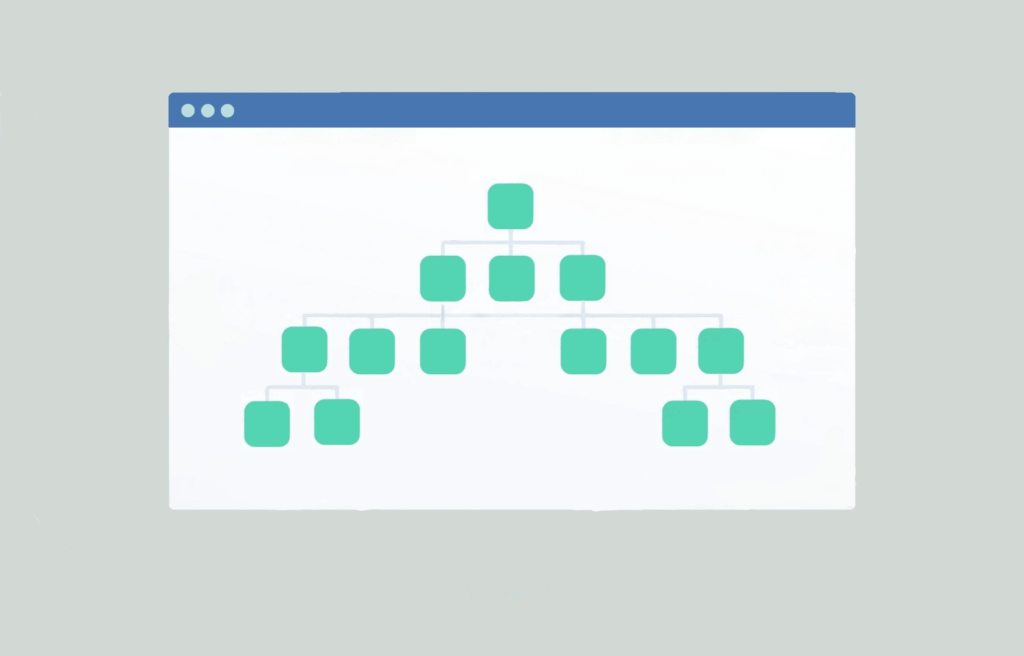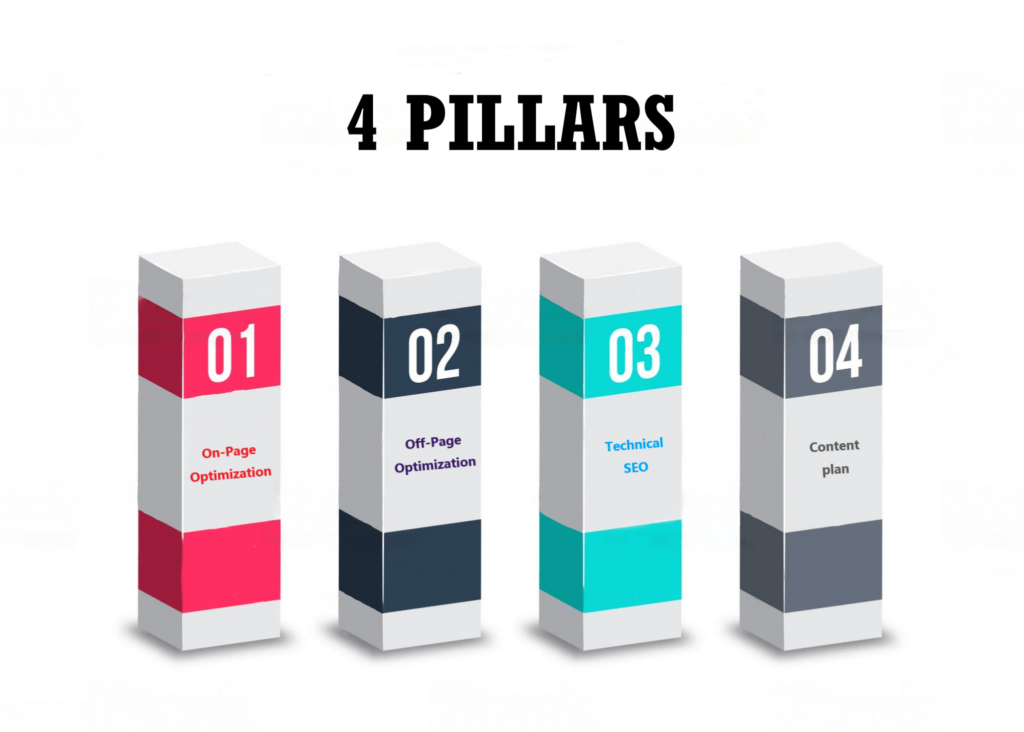Guide of The Complete Pillar and Silo SEO Strategy

Introduction
The Complete Pillar and Silo SEO Strategy is a thorough method for search engine optimization of your website. You may raise the search engine rating, increase traffic, and boost conversions for your website by producing high-quality content for your posts and structuring it into SEO pillar and SEO silo structures. This technique entails selecting central themes that are pertinent to your company and developing in-depth, educational content around those themes.
Then, this information is arranged into a pillar and silo structure, with the pillar information serving as the primary topic and the silos information assisting and elaborating on it. By using this method, you may enhance the SEO of your website while simultaneously giving your audience valuable information through interesting and engaging content. Therefore, think about using the Complete Pillar and Silo SEO Strategy if you want to beat the competition and enhance your online presence.
Pillar Page
A pillar page, often referred to as a cornerstone page, is a thorough and authoritative article that acts as the website’s central core for a certain subject or theme. It is often a lengthy, in-depth article or webpage that covers a wide range of topics and offers a comprehensive summary of the subject.
A pillar page’s function is to group and arrange related subtopics or sub-categories under a main page. It serves as a hub for supporting and linking to more specialized and in-depth material, often known as cluster content or subtopic sites.
What is silos technique in Search Engine Optimization(SEO)?
The silo technique in search engine optimization, sometimes referred to as the silo architecture or siloing, is a website architectural strategy that entails arranging and combining material into subject groups or silos. By creating a clear hierarchy and subject relevance within a website, the silo strategy aims to make it simpler for search engines to comprehend the context and relevance of the material.
The content posts of the website are separated into SEO silos based on connected topics or themes in the silo technique. Within each silos, there are supporting subtopics or clusters of content. Each silos represents a different category or pillar topic. Each silo’s content is connected to one another, forming a solid internal linking system.
Advantages of implementing silos technique in SEO
The following are the main advantages of using the silo strategy in SEO:
- Increased Relevance: Search engines may better comprehend the thematic focus and relevance of each component of your website when material is organized into silos. This can increase your website’s visibility and rating for particular keywords or themes.
- Improved User Experience: By offering a logical and well-organized navigation structure, siloing enhances the user experience. Within each silos, users can quickly locate and navigate through related material, improving the user experience and boosting engagement.
- Strong Internal Linking: Each silos is encouraged to have internal links that bring pages of pertinent content together. This aids in the distribution of link power and informs search engines of the significance and connections between the pages contained within a silo.
You would normally begin by determining the primary pillar subjects or categories pertinent to your website before putting the silo strategy into practice. Then, you develop top-notch pillar material for each silo that covers the broad outlines of the subject. Within each silos, supporting cluster content is produced to address more specialized subtopics or facets.
The pillar content and the cluster material within each silo must be properly linked internally. This aids search engines in comprehending the hierarchies and topical linkages on your page.
The silo strategy can help you organize, make your website more relevant, and make it more user-friendly, all of which will ultimately boost its SEO performance and user engagement.
Importance and Advantages of Pillar Pages
Implementing a content strategy known as topic clustering or pillar content strategy requires pillar pages. The pillar page acts as the primary anchor for a specific topic in this method, and cluster content pieces are built around it. The cluster content links to the pillar page and each other while delving further into particular subtopics or pillar page-related elements.
The advantages of using pillar pages include:
- Improved SEO: Pillar pages assist search engines including Google in comprehending the primary subject and organization of the content on your website. You can improve your website’s exposure and ranks in search engine results for the desired topic by grouping and connecting related content together.
- User-Friendly Navigation: Pillar pages give consumers a thorough overview of a topic and make it easier for them to navigate through the associated subtopics. Users can visit the pillar page to gain a more comprehensive perspective before exploring particular cluster content pieces for more in-depth knowledge.
- Authority and Thought Leadership: By developing an in-depth and educational pillar page, you can position your website as the industry expert and go-to resource on the subject. With your audience, this can assist establish credibility and trust.
- Increased Engagement: As visitors explore the numerous subtopics and associated material, pillar pages encourage them to stay on your website longer. This may result in better customer happiness, greater engagement, and fewer bounce rates.
It’s crucial to make sure your pillar page is thorough, organized, and contains all of the relevant information. In order to encourage further research, it should offer insightful information and link to pertinent cluster content. The pillar page’s associated cluster content will be kept current and relevant over time if it is routinely updated and maintained.
Guide on How to Create the Best Pillar Page for Your Site?
There are various processes involved in building a successful pillar page for your website. The greatest pillar page creation advice is provided here:
- Pick a Topic That Is Relevant: Pick a wide topic that is pertinent to your target audience and fits with your company’s goals. To find hot subjects in your market that are valuable and popular, think about conducting keyword research.
- Conduct Thorough Research: Compile data and carry out in-depth research on the subject of choice. Gather facts, figures, case studies, professional judgments, and any other pertinent information that may benefit your pillar page.
- Outline the structure: Make a structure for your pillar page that is both clear and sensible. Decide which major issues or subtopics you wish to address, and then decide how they should be presented. This will provide you a structure for setting up your content.
- Create Comprehensive and Engaging material: Create in-depth and interesting material for each part of your pillar page. Cover the essential elements of the subject, and give your audience insightful details and knowledge. To improve the readability and aesthetic appeal of your page, combine text with photographs, infographics, and other multimedia components.
- Use Visual Hierarchy: To produce a visually appealing and scannable pillar page, use headings, subheadings, bullet points, and formatting strategies. Users will find it simpler to navigate and get the information they need as a result.
- Improve for SEO: Perform keyword research and naturally sprinkle pertinent keywords all across your page pillar. Improve the headings, meta description, page title, and image alt text. For the best SEO results, make sure your content is well-structured, responsive to mobile devices, and loads rapidly.
- Linking: Include both internal and external links on your pillar page to direct people to more detailed cluster content pages or other pertinent resources on your website. Include external links to reliable, credible sites that expand on your points or provide evidence for them.
- Update and Maintain: To keep your pillar page current and pertinent, regularly examine and update it. Update statistics, add new data, and update any out-of-date material. To find areas for improvement, track user comments, engagement metrics, and search engine rankings including Google.
- Promote Your Pillar Page: Once your pillar page has been published, you should advertise it using a variety of platforms, such as social media, email marketing, and cold-calling influential people in your business or relevant websites. This can improve its visibility, draw more visitors, and provide backlinks.
- Monitor Performance: Use analytics tools to monitor the effectiveness of your pillar page. Keep track of statistics like page visits, time spent on the page, bounce rate, and conversions. To increase user engagement and conversions, analyze user behavior and make changes.
By following these instructions, you can make a well-organized and educational pillar page that benefits your audience, aids in SEO, and positions your website as an authority resource on the subject of choice.
How to implement SILO structure in SEO?
There are various processes involved in setting up a silo structure in SEO. The following is a guidance on how to use the silo approach successfully:
- Keyword Research: Conduct keyword research to find pertinent keywords and topics that are compatible with your website and intended audience. This will assist you in selecting the key silo pillar subjects.
- Establish Silo Categories: Create unique silo categories based on the keyword research to which you have been exposed. Each silo should reflect a significant subject or idea that will act as a central center for content.
- Create Pillar material: For each silo, provide extensive pillar material. The pillar content ought to give a thorough overview of the subject and cover all of its major facets. Focus on producing original, informative, and high-quality content.
- Create Cluster Content: Within each silo, produce supporting cluster content that explores in greater detail particular pillar content-related subtopics or facets. Cross-link between pertinent cluster pages and link these pages with their corresponding pillar material.
- Optimize On-Page Elements: Make your pillar and cluster pages’ on-page components as effective as possible. This entails adding pertinent keywords to the page names, meta descriptions, headings, and content. Make sure the content is organized correctly, is simple to read, and offers a positive user experience.
- Internal connection: Within each silo, create a solid internal connection system. Link the cluster content to the pillar content and the opposite. Search engines including Google may better grasp the relationships and hierarchy between the sites inside each silo thanks to this internal linking.
- XML Sitemap: Produce an XML sitemap that lists each silo’s pillar and cluster pages. To make it easier for search engines including Google to find and crawl your silo structure, submit the sitemap to them.
- Monitor and Modify: Continue to assess how your silo structure and individual pages are performing. Analyze user engagement data, conversions, organic traffic, and search engine rankings including Google. To maximize the effectiveness of your silo structure, make the appropriate improvements, such as upgrading content or strengthening internal connectivity.
To deploy a silo structure successfully, keep in mind that careful planning, content organization, and constant monitoring and optimization are all necessary. You can enhance the topical relevance, search engine exposure, and user experience of your website by organizing it utilizing the silo strategy.
Four Pillars of SEO

The four pillar of SEO includes a number of components that help your SEO efforts to succeed overall. The entire SEO pillar is broken down in the following manner:
On-Page Optimization: This entails making adjustments to specific web pages in order to enhance their exposure and relevance in search engine results including Google. It involves improving URLs, headings, content, pictures, and page names and meta descriptions. Researching keywords and naturally inserting them into the content are also part of on-page optimization.
Off-Page Optimization: Off-page optimization refers to actions taken away from your website that have an effect on how it ranks in search results. This encompasses social media marketing, influencer outreach, creating high-quality backlinks from reliable websites, and managing one’s online reputation. The authority and reputation of your website in the eyes of search engines including Google are enhanced via off-page optimization.
Technical SEO: Technical SEO focuses on the technical elements of your website that affect how search engines see it and how they crawl it. It entails enhancing website functionality and speed, assuring responsive and mobile-friendly design, optimizing site architecture and navigation, putting in place the right URL structure, utilizing structured data markup, and fixing problems like duplicate content and broken links.
Content plan: For SEO success, a thorough content plan must be developed. In order to achieve this, high-quality, beneficial, and pertinent content must be produced that matches user search intent. Incorporating multimedia features, pillar content creation, keyword and user experience optimization, identification of target keywords, and continuous updating and refreshing of material are all part of a content strategy.
Conclusion
In conclusion, the Complete Pillar and Silo SEO Strategy gives a holistic method to optimizing your blog or website for search engines including Google and boosting its overall exposure and performance. By organizing your content architecture into pillar pages and supporting silo pages, you create a clear and logical structure that search engines can easily crawl and understand.
This strategy enables you to focus on creating high-quality, in-depth content pillar that cover broad topics, establishing your blog or website as an authority in your industry. The supplementary silo pages then go into greater detail about particular subtopics, establishing a hierarchy of connected content that improves the overall relevance and coherence of your blog or website.
By directing users through a logical content flow and giving them in-depth answers to their search queries, the Pillar and Silo SEO Strategy improves the user experience. This not only boosts interaction but also encourages users to stay on your blog or website longer, which ultimately boosts conversion rates and produces more leads or sales.
Additionally, this approach is consistent with search engine algorithms that emphasize relevance and user intent. You increase your chances of appearing higher in search engine results including Google and drawing in qualified organic traffic by structuring your content to reflect how users search for and consume information.
The Complete Pillar and Silo SEO Strategy is a potent tool for improving the organization, content, and user experience of your blog or website. By putting this method into practice, you can raise your blog or website’s search engine visibility including Google, establish it as an authority, and give your target market useful information. Take advantage of the Pillar and Silo SEO Strategy to boost the SEO performance of your blog or website.
FAQs
What is the complete pillar of SEO?
The phrase “complete pillar of SEO” describes a comprehensive strategy that incorporates on-page optimization, off-page optimization, technical SEO, content strategy, user experience, website authority, analytics, and monitoring.
What is silo SEO strategy?
The SEO silos strategy divides information into silos or theme groups as a way of arranging websites. Through the provision of a simple and well-organized navigation structure, it aids search engines including Google in comprehending the topical importance of your website and enhances user experience.
How is my website helped by the silo SEO strategy?
The SEO silos strategy enhances the organization and relevancy of the material on your website, improving both its exposure and positioning in search results. It improves user experience, making it simpler for website users to access pertinent content, and it promotes internal linking, which can raise your website’s total ranking potential.
What essential elements make up the silo SEO strategy?
The creation of content pillars for each silo, the development of supporting cluster content, the optimization of on-page elements, the establishment of internal linking within silos, the monitoring and adjustment of the silo structure based on performance analysis are the key elements of the silo SEO strategy.
How does each SEO pillar work together to increase overall success?
The entire SEO pillar guarantees a thorough approach to improving your website. It covers all crucial topics such as technical SEO, content strategy, user experience, website authority, and analytics, as well as on-page and off-page optimization. Together, these pillars contribute to increase website success overall, user engagement, and search engine exposure including Google.
Does the full pillar and silo SEO approach involve just one step?
SEO is a never-ending effort. The full pillar and silo SEO approach needs ongoing monitoring, optimization, and adaptation to keep up with shifting user behavior, search engine trends, and industry standards. To find areas for improvement and keep your website’s competitive edge, regular performance metric analysis is imperative.
Can I implement the silo SEO technique without using the complete pillar method?
While the silo SEO method helps websites stay organized and relevant, it is advised to use all four SEO pillars for thorough optimization. The full pillar approach ensures that your SEO strategy is well-rounded and addresses all important SEO factors, increasing your chances of success in terms of search engine rankings including Google and user engagement.
